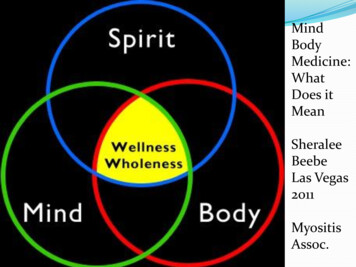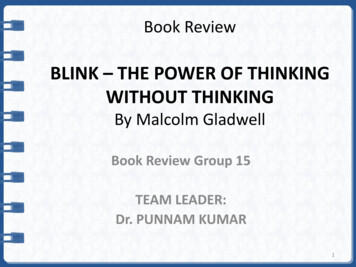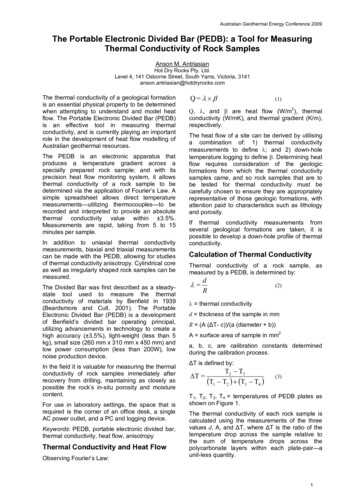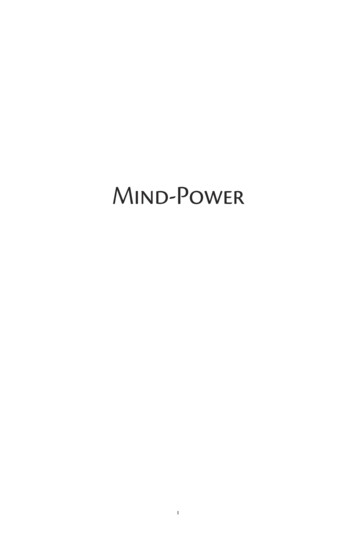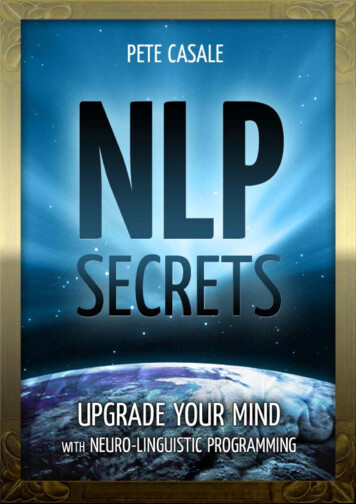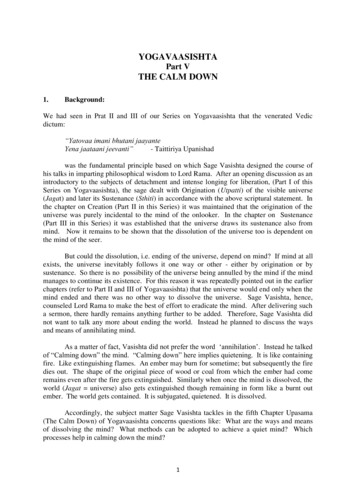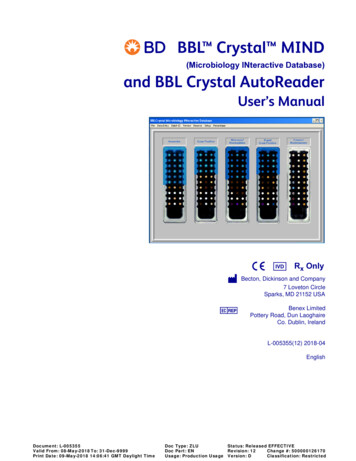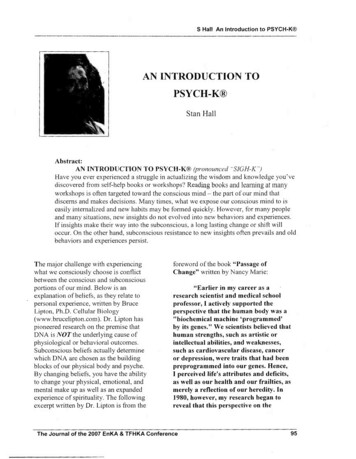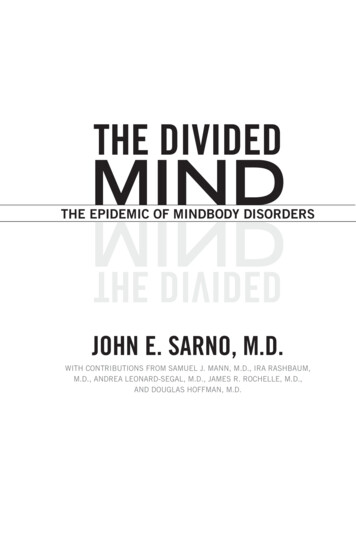
Transcription
THE DIVIDEDMINDMINDTHE EPIDEMIC OF MINDBODY DISORDERSTHE DIVIDEDJOHN E. SARNO, M.D.WITH CONTRIBUTIONS FROM SAMUEL J. MANN, M.D., IRA RASHBAUM,M.D., ANDREA LEONARD-SEGAL, M.D., JAMES R. ROCHELLE, M.D.,AND DOUGLAS HOFFMAN, M.D.
CONTENTSIntroduction1ONE What Is Psychosomatic Medicine?7TWO A Brief History of Psychosomatic Medicine45THREE The Psychology of Psychosomatic DisordersFOUR Treatment89129FIVE Hypertension and the Mindbody Connection: A New Paradigm185by Samuel J. Mann, M.D.SIX My Experience with Tension Myositis Syndrome227by Ira Rashbaum, M.D.SEVEN A Rheumatologist’s Experience with Psychosomatic Disordersby Andrea Leonard-Segal, M.D.EIGHT My Perspective on Psychosomatic Medicine271by James R. Rochelle, M.D.NINE Structural Pain or Psychosomatic Pain?299by Douglas Hoffman, M.D.TEN A Family Doctor’s Experience with Mindbody Medicineby Marc Sopher, M.D.ReferencesIndex375369333245
About the AuthorOther Books by John E. Sarno, M.DCreditsCover
INTRODUCTIONHealth care in America is in a state of crisis. Certain segments ofAmerican medicine have been transformed into a dysfunctionalnightmare of irresponsible practices, dangerous procedures, bureaucratic regulations, and skyrocketing costs. Instead of healing people,the broken health care system is prolonging people’s suffering in toomany cases. Instead of preventing epidemics, it is generating them.Does this judgment sound too harsh? Let’s look at some statistics. Over six million Americans suffering from the mysterious andexcruciatingly painful ailment called “fibromyalgia” are being treatedby an army of self-minted specialists, not one of whom has a clue asto what causes the disorder. Millions more are suddenly beingtreated for gastric reflux, at an annual cost of billions of dollars. Whosays heartburn can’t be profitable? And millions more—many ofthem youngsters—are dependent on mind-altering drugs which, itnow turns out, may actually be endangering their lives.The circumstances are serious. I am not overstating the situation. That’s why my colleagues and I have written this book.The Divided Mind is about the principles and practice of psychosomatic medicine. It is not about alternative medicine, or some
2THE DIVIDED MINDtrendy New Age regimen. It is about straightforward, clinicallytested medicine, as practiced by licensed physicians for over thirtyyears, working with thousands of patients.First, I want to clear up any confusion surrounding the wordpsychosomatic. You may think it refers to something vaguely fraudulent, such as imaginary diseases dreamed up by people for their ownselfish or confused reasons. That’s simply not true. But even medicalpractitioners, doctors who might be expected to have a more accurateunderstanding of the term, sometimes make the mistake of assuming it refers to how stress makes disease worse, or the stressful consequences of living with a disease. Those are legitimate concerns andhave been addressed in the medical literature, but they are not psychosomatic. Psychosomatic medicine specifically refers to physicaldisorders of the mindbody, disorders that may appear to be purelyphysical, but which have their origin in unconscious emotions, a verydifferent and extremely important medical matter. Note that we willuse the terms psychosomatic and mindbody interchangeably throughout the book, so don’t let it throw you.There are literally hundreds of disorders and illnesses that havebeen identified as purely psychosomatic or having a psychosomaticcomponent. We will explore many of them in the pages that follow.They can range from mildly bothersome back pain all the way tocancer, depending on the power and importance of unconsciousemotional phenomena. Psychosomatic illnesses seem to be an inescapable part of the human condition. Yet amazingly, in spite of thenearly universal prevalence of such disorders, the practice of psychosomatic medicine is almost totally unknown within today’s medicalcommunity, and plays virtually no part in contemporary medicalstudy and research. Nowadays, when physicians and many psychiatrists are confronted with a psychosomatic disorder, they do not recognize it for what it is and almost invariably treat the symptom.
INTRODUCTION3The enormity of this miscarriage of medical practice may becompared to what would exist if medicine refused to acknowledgethe existence of bacteria and viruses. Perhaps the most heinous manifestation of this scientific medievalism has been the elimination ofthe term psychosomatic from recent editions of the Diagnostic andStatistical Manual of Mental Disorders (DSM), the official publication of the American Psychiatric Association. One might as welleliminate the word infection from medical dictionaries.This astonishing state of affairs—scandalous really—did not occur overnight. For the first half of the twentieth century the studyand treatment of psychosomatic disorders was recognized by manymedical professionals as a promising and important new frontier ofmedicine. Then, about fifty years ago, the American medical community took a wrong turn and simply abandoned its interest in psychosomatic medicine. I shall speculate on why this happened, but fornow the important thing to note is that as a direct result of turningits back on this vital branch of medicine, the medical profession hashelped to spawn epidemics of pain and other common disorders affecting the lives of millions of Americans.I came upon psychosomatic medicine well along in my professional career, when I began to see large numbers of people sufferingfrom those common but sometimes mysterious conditions associatedwith bodily pain, primarily of the low back, neck, trunk, and limbs. Idid not know these disorders were psychosomatic. I had not trainedin psychiatry or psychology, and it was only through direct daily confrontation with the suffering of my patients that I eventually cameto recognize the true nature of their distress, and could then begin toadminister effective treatment. Over the last thirty-two exciting andfruitful years, my colleagues and I have learned much. I’ve publishedthree books to describe our work, our discoveries, and our successes.Those dealt largely with what I called the tension myositis syndrome
4THE DIVIDED MIND(TMS), a painful psychosomatic disorder afflicting millions. The Divided Mind will deal with the full range of psychosomatic disorders,a far broader and more important subject. Psychosomatic disordersfall into two categories:1. Those disorders that are directly induced by unconsciousemotions, such as the pain problems (TMS) and common gastrointestinal conditions including reflux, ulcers,irritable bowel syndrome, skin disorders, allergies, andmany others.2. Those diseases in which unconscious emotions may play arole in causation, but are not the only factor. They includeautoimmune disorders like rheumatoid arthritis, certaincardiovascular conditions, and cancer. No one, as far as Iknow, who is currently studying these disorders includesunconscious emotions as potential risk factors. To mymind, this borders on the criminal.Psychosomatic processes begin in the unconscious, that dark,unmapped, and generally misunderstood part of our minds firstidentified by Sigmund Freud. Though it has yet to be appreciated byeither physical or psychiatric medicine, unconscious emotions are apotent factor in virtually all physical, nontraumatic ills. I gave thisbook the title The Divided Mind because it is in the interaction ofthe unconscious and conscious minds that psychosomatic disordersoriginate. Those traits that reside in the unconscious that we consider the most troublesome, like childishness, dependency, or the capacity for savage behavior, are the products of an old, primitive partof the brain, anatomically deep, just above the brain stem. Evolutionhas added what is called the neocortex, the new brain, the brain of
INTRODUCTION5reason, higher intelligence, communication, and morality. There appears to be an ongoing struggle between these two parts of thebrain. Sometimes reason prevails, and at other times the more childish, bestial part of human nature is dominant. This duality is onereason for psychosomatic disorders, as will be demonstrated.The conclusions found in this book are not based on armchairdeductions. They are the result of many years of experience withthousands of patients, and are reinforced by the findings of highlytrained psychotherapists. In addition, six pioneering physicians fromaround the United States who have incorporated psychosomaticprinciples in their practices and research have also contributed findings based on their own experiences. Our successful treatment of aremarkably high percentage of patients dynamically supports ourfindings.The Divided Mind is intended primarily to explain the nature ofthe psychosomatic process, particularly the psychology that leads toclearly obvious physical symptoms. The book’s secondary purpose isto draw attention to the blinkered attitudes of too many practitioners of contemporary medicine who fail not only to acknowledge theexistence of psychosomatic disorders, but who actually contribute totheir spread by their failure to do so.I undoubtedly will be challenged by the guardians of perceivedwisdom for the so-called “lack of scientific evidence” for my diagnostic theories. This is almost ludicrous since there is no scientificevidence for some of the most cherished conventional concepts ofsymptom causation. The most glaring example of this is the ideathat an inflammatory process is responsible for many painful states,for which there is no scientific evidence. Another example: studieshave never been done to validate the value of a variety of surgicalprocedures employed for pain disorders, like laminectomy for intervertebral disk abnormalities.
6THE DIVIDED MINDStudying psychosomatic disorders in the laboratory poses somegreat problems. How do you identify and measure unconscious emotions? If acceptance of the diagnosis by the patient is critical to successful treatment, how can you demonstrate the validity of thediagnosis and treatment if most of the population doesn’t accept thediagnosis? After many years of experience it is our impression thatnot more then 10 to 15 percent of the population would be willing toaccept a psychosomatic diagnosis. Our proof of validity is the remarkable success of our therapeutic program.As Freud noted, the physiology of the process is far less important than accurate observations of the process itself. He didn’t haveany laboratory data either. So I must leave it to the laboratory expertsto figure out the nuts and bolts of the process.By sharing with you focused experiences in the diagnosis andtreatment of large numbers of people who have suffered and are suffering from psychosomatic pain, my fellow doctors and I hope thatour findings will have an important influence on medical practice,particularly in view of the millions who now suffer these disordersneedlessly.In conclusion I must express my deep gratitude to Mr. Al Zuckerman, who succeeded in finding a publisher for this rather controversial book.
ONEWHAT ISPSYCHOSOMATICMEDICINE?I remember the first time John R came into my clinic in 1996. Hewas a successful businessman in his early forties, well dressed and fit,radiating confidence. He seemed altogether at ease and selfassured—until he bent to sit down. Abruptly, his movements slowedand he became so cautious, so fragile, so tentative that he was suddenly a caricature of the driving, confident man who strode throughmy door only moments before. His body language made it clear thathe was either experiencing excruciating pain or feared the painwould strike him if he made the slightest wrong move.As a medical doctor, I could empathize with his suffering. Myspecialty is mindbody disorders, and I see cases like this every working day. I hoped I could help him, which meant helping him to helphimself, because with mindbody disorders, a doctor cannot “cure” a
8THE DIVIDED MINDpatient. It is the suffering patient who must come to understand hismalady . . . and by understanding it, banish it.As we went over John R’s history, a picture began to emerge ofan interesting and satisfying life. Married, three children. His ownbusiness, which probably took up too much of his time, but was doing well. I also heard a familiar litany of suffering and pain—achronic bad back of mysterious origins, sometimes inducing such severe pain that he could not get out of bed in the morning. His longand unsuccessful search for relief—experiments with alternativemedicine, prescription drugs, and finally, in desperation, surgery—immensely expensive and only temporarily successful. Then the sudden onset of brand-new ailments: sciatica, migraine headaches, acidreflux—the list of maladies went on and on.As a physician, my heart went out to him. It was my job to helphim. But I could only lead. Would John R follow? Would he understand the profound interconnectedness of mind and body? Would hegrasp the awesome power of buried rage?To the uninitiated, there is often something mysterious aboutmindbody medicine. In truth, the relationship of the mind to thebody is no more mysterious than the relationship of the heart to thecirculation of the blood, or that of any other organ to the workingsof the human body. My first interview with John R indicated hewould be open to the idea of mindbody medicine. Within a monthof beginning treatment, his pains, which had tortured him for muchof his adult life, simply disappeared, without the use of drugs or radical procedures. I still get an annual Christmas card from him. In hismost recent one he reported that he continues playing tennis andskiing. Last summer he and his oldest boy walked the entire Appalachian Trail. The pain and the equally unexplained other disorders have not returned.Many of my patients have an initial difficulty grasping the full
WHAT IS PSYCHOSOMATIC MEDICINE?9dynamics of the mindbody syndrome. It is one thing to accept theconcept that the mind has great power over the body, but quite another to internalize that knowledge, and to understand it on a deeplypersonal basis. Even when my patients come to fully appreciate thecentral element of the equation—that it is their mind that containsthe root cause of their physical distress—they may continue tostumble over the secondary details, unable to accept the reality oftheir own buried rage, and remain puzzled over the fact that theirown mind can make decisions of which they are unaware.Sometimes it helps my patients to understand the mindbodyconnection if they step back and look at it from a broader perspective. Psychosomatic disorders belong to a larger group of entitiesknown as psychogenic disorders, which can be defined as any physicaldisorders induced or modified by the brain for psychological reasons.Some of these manifestations are commonplace and familiar toall, such as the act of blushing, or the feeling of butterflies in thestomach, or perspiring when in the spotlight. But these are harmlessand temporary phenomena, persisting only as long as the unusualstimulus remains.A second group of psychogenic disorders includes those cases inwhich the pain ofa physical disorder is intensified by anxieties and concerns not directly related to the unusual condition. An examplewould be someone recently involved in a serious automobile accidentwhose pain may be significantly worsened by concerns about his orher family, job, and so on, not about the injuries. While mainstreammedicine tends to ignore almost all psychogenic manifestations, itgenerally acknowledges this type, recognizing that symptoms mayworsen if the patient is anxious. Doctors may refer to this as emotional overlay. In my practice, patients have reported that their painbecame much more severe when they were informed of the resultsof a magnetic resonance imaging (MRI) scan that described an ab-
10THE DIVIDED MINDnormality, such as a herniated disk, particularly if surgery was suggested as a possible treatment.The third psychogenic group is the exact opposite of the second:it covers cases in which there is a reduction of physical symptoms in anexisting disorder. In one of the earliest studies of pain, HenryBeecher of Harvard reported that in a group of severely woundedsoldiers in World War II, it was found that despite the severity oftheir injuries they often required little or no analgesic medication because their pain was substantially lessened by their becoming awarethat they were still alive, being cared for and removed from the dangers of deprivation, hardship, and sudden death.By far the most important psychogenic categories are the fourthand fifth groups, hysterical disorders and psychosomatic disorders. Hysterical disorders are mostly of historical interest, although the psychology of both is identical. My experience has been primarily withpsychosomatic disorders.The symptoms of hysterical disorders are often quite bizarre.The patient may experience a wide variety of highly debilitatingmaladies, including muscle weakness or paralysis, feelings of numbness or tingling, total absence of sensation, blindness, inability to usetheir vocal cords, and many others, all without any physical abnormalities in the body to account for such symptoms.It is clear from the nature of hysterical symptoms that their origin is indeed “all in the head,” to take a pejorative phrase commonlyused to refer to psychosomatic symptoms. The absence of any physical change to the body indicates that the symptoms are generated bypowerful emotions in the brain. Just where in the brain, no one cansay for sure. One medical authority, Dr. Antonio R. Damasio, hassuggested that these emotion-generating centers are located in thehypothalamus, amygdala, basal forebrain, and brain stem. The pa-
WHAT IS PSYCHOSOMATIC MEDICINE?11tients perceive symptoms as though they were originating in thebody when the appropriate brain cells are stimulated. These symptoms often have a very strange and unreal quality about them. Oneof the nineteenth-century pioneers of psychiatry, Josef Breuer,likened them to hallucinations.PSYCHOSOMATIC DISORDERSBy contrast, in the fifth psychogenic group, psychosomatic disorders,the brain induces actual physical changes in the body. An example ofthis would be tension myositis syndrome (TMS), a painful disorderthat we will examine at greater length. In this condition, the brainorders a reduction of blood flow to a specific part of the body, resulting in mild oxygen deprivation, which causes pain and other symptoms, depending on what tissues have been oxygen deprived.One of the most intriguing aspects of both hysterical and psychosomatic disorders is that they tend to spread through the population in epidemic fashion, almost as if they were bacteriological innature, which they are not. Edward Shorter, a medical historian,concluded from his study of the medical literature that the incidenceof a psychogenic disorder grows to epidemic proportions when thedisorder is in vogue. Strange as it may seem, people with an unconscious psychological need for symptoms tend to develop a disorderthat is well known, like back pain, hay fever, or eczema. This is not aconscious decision.A second cause of such epidemics often results when a psychosomatic disorder is misread by the medical profession and is attributedto a structural abnormality, such as a bone spur, herniated disc, etc.A 1996 study in Norway suggests there is a third condition thatfuels such epidemics: the simple fact that medical treatment may be
12THE DIVIDED MINDreadily available. A paper published in the journal Lancet in 1996 described an epidemic in Norway of what is called “whiplash syndrome.” People involved in rear-end collisions, though not seriouslyinjured, were developing pain in the neck and shoulders followingthe incident. Norwegian doctors were puzzled by the epidemic anddecided to investigate. They went to Lithuania, a country with nomedical insurance, and on the basis of a controlled study determinedthat the whiplash syndrome simply did not exist in that country. Itturned out that the prevalence of whiplash in Norway had less to dowith the severity of rear-end collisions than with the fact that it wasin vogue; doctors couldn’t explain the epidemic and the ready availability of good medical insurance for treatment!The most important epidemics of psychosomatic disorders arethose associated with pain. As will be discussed below, they have become the ailments du jour for millions of Americans. They are “popular” and most of them have been misdiagnosed as being the resultof a variety of physical structural abnormalities, hence their spreadin epidemic fashion.What is the genesis of a psychosomatic disorder? As we shall see, thecause is to be found in the unconscious regions of the mind, and aswe shall also see, its purpose is to deliberately distract the consciousmind.The type of symptom and its location in the body is not important so long as it fulfills its purpose of diverting attention from whatis transpiring in the unconscious. On occasion, however, the choiceof symptom location may even contribute to the diversion process,something that is common with psychosomatic disorders. For example, a man who experiences the acute onset of pain in his arm whileswinging a tennis racket will naturally assume that it was something
WHAT IS PSYCHOSOMATIC MEDICINE?13about the swing that hurt his arm. The reality is that his brain hasdecided that the time is ripe for a physical diversion and chooses thatmoment to initiate the pain, because the person will assume that itstems from an injury, not a brain-generated physical condition thatcaused the pain. How does the brain manage this trick? It simplyrenders a tendon in the arm slightly oxygen deprived, which resultsin pain. This is how “tennis elbow” got its name. If that soundsbizarre, diabolical, or self-destructive, you will see later that it is inreality a protective maneuver. My colleagues and I have observed itin thousands of patients.But in time, such a symptom may lose its power to distract. Thenthe psyche has another trick up its sleeve. It will find another symptom to take its place, one that is viewed by both patient and doctor as“physical,” that is, not psychological in origin. For instance, if atreatment—let’s say surgery—neutralizes a particular psychogenicsymptom, so that the symptom loses its power to distract, the brainwill simply find another target and create another set of symptoms. Ihave called this the symptom imperative and it has enormous publichealth implications, because psychogenic symptoms are commonlymisinterpreted and treated as physical disorders. All of a sudden, the“cured” patient has a brand-new disorder that demands medical attention. More distress. More time lost. More expense. This will bedocumented as we proceed.Statistically, the most common psychosomatic disorder today isTMS, which I have described in its many forms in my previousbooks. I gave it that name because at the time of publication of thefirst book in 1984, it was thought that muscle (myo) was the only tissue involved. Since then, I have come to learn that nerve and tendontissue may also be targeted by the brain; in fact, it now appears that
14THE DIVIDED MINDnerve involvement is more common than muscle. Accordingly, amore inclusive name, like musculoskeletal mindbody syndrome, mightbe more appropriate. However, because the term TMS is now so wellknown, I have been urged by my colleagues not to change it, so TMSit remains.DISORDERS MEDIATED THROUGH THE AUTONOMIC-PEPTIDESYSTEMHow does the brain induce symptoms in the body? There are a number of ways, but by far the largest number of psychosomatic conditions are created through the activity of the autonomic-peptide system.The autonomic branch of the central nervous system controls the involuntary systems in the body, such as the circulatory, gastrointestinal, and genitourinary systems. It is active twenty-four hours a dayand functions outside of our awareness. The word peptides has beenadded because peptides are molecules that participate in a system ofintercommunication between the brain and the body and play an important part in these processes.The most common disorders produced through this system arethose of TMS, described above. These disorders afflict millions andcost the economy billions of dollars every year in medical expenses,lost work time, compensation payments, and the like.Other conditions include: Gastroesophageal refluxPeptic ulcer (often aggravated by anti-inflammatory drugs)EsophagospasmHiatus herniaIrritable bowel syndromeSpastic colitis
WHAT IS PSYCHOSOMATIC MEDICINE?15 Tension headache Migraine headache Frequent urination (when not related to medical conditionssuch as diabetes) Most cases of prostatitis and sexual dysfunction Tinnitus (ringing in the ears) or dizziness not related toneurological diseaseThe theories advanced here are based almost exclusively on workdone with TMS, but there are many less common mindbody disorders (like reflux) whose symptoms are also created by the autonomicpeptide system. We refer to these as equivalents of TMS since theyare the result of the same psychological conditions that are responsible for TMS. What put me onto the possibility that the pain I wasseeing in the early 1970s was psychosomatic was the fact that somany of the pain patients had experienced these equivalent disorders, all of which I knew to be psychosomatic. That realization suggested that the pain disorder I was seeing was also psychosomatic.WHY TMS IS PAINFULAs I stated earlier, the altered physiology in TMS appears to be amild, localized reduction in blood flow to a small region or a specificbody structure, such as a spinal nerve, resulting in a state of mildoxygen deprivation. The result is pain, the primary symptom ofTMS. The tissues that may be targeted by the brain include themuscles of the neck, shoulders, back, or buttocks; any spinal or peripheral nerve; and any tendon. As a consequence, symptoms mayoccur virtually anywhere in the body. The nature of the pain variesdepending on the tissues involved: muscle, nerve, or tendon. In addition to pain, nerve involvement brings with it the possibility of feel-
16THE DIVIDED MINDings of numbness and tingling and/or actual muscle weakness.These reflect the function of nerves, which is to bring sensory information to the brain and carry movement messages to the body, either or both of which may be affected in TMS. The fact thatpatients recover rapidly when they are appropriately treated suggeststhat the tissues involved—nerve tissue being the most sensitive—arenot in any way damaged but only rendered temporarily dysfunctional.Because so few members of the medical profession recognizemindbody disorders for what they are, the pain of TMS is commonly attributed to a structural abnormality, such as the ones thatoften show up on x-rays, computed tomography (CT), or MRIscans. Following is a list of the most common ones:Abnormalities of the intervertebral disc due to wear and tear,aging, etc., including: Narrowing of the disc space, indicating that the disc haslost substance Bulging of the disc, due to pressure from the material inside the disc (the nucleus pulposus) Herniation of disc materialAbnormalities of other spinal bone elements, referred to asspondylosis (immobility and fusion of vertebral joints)including: Bone spurs around spinal bone joints (“pinched nerve”) Enlargement of ligaments in the spinal canal Narrowing of the spinal canal due to the changes above(spinal stenosis) Spondylolisthesis (malalignment of spinal bones)
WHAT IS PSYCHOSOMATIC MEDICINE?17 Scoliosis (an abnormal side-to-side curvature of the spine) Abnormalities of tendons of rotator cuff muscles in theshoulder Tears of the knee cartilage (meniscus) Normal aging changes in the knee, called arthritis Changes in the hip caused by aging changes (arthritis) Bone spurs in the heel of the foot Many others less common conditionsIn my experience, the majority of these abnormalities are not responsible for the pain. The cause of the pain is TMS, plain and simple. Nevertheless, despite the absence of proof that theabnormalities are the cause of the pain, the medical profession routinely treats those with surgery—in many cases, exorbitantly expensive surgery—as will be detailed.To further complicate the problem, there are a number of softtissue disorders that are also blamed for the pain of TMS. Thesemisdiagnoses include: Myofascial pain, usually in the back (actual cause unknown) The postpolio syndrome (pain in parts of the body previously afflicted by polio). Such pain is routinely attributedto the polio, but there is no proof that this is the cause.There is a Latin phrase commonly quoted in scientificcircles that refers to this particular kind of misdiagnosis:“post hoc ergo propter hoc.” It means “after this [i.e, polio] therefore because of this,” a classic error in logicleading to a dangerous and unscientific conclusion. Strained back or neck muscles
18THE DIVIDED MIND Pain in the buttock attributed to compression of the sciaticnerve by the piriformis muscle—a rather frivolous concept with no evidence of validity Pain and other dental abnormalities (temporomandibularjoint disorder [TMS]) that are most likely due to TMSin jaw muscles Tendon pain in various locations around the elbow attributed to overuse (tennis elbow) Wear or tear of rotator cuff tendons Pain in the front of the sole of the foot (metatarsalgia) Pain in the middle of the sole of the foot (plantar fasciitis) Pain in the heel of the foot (bone spur) Pain attributed to a benign tumor in the sole of the foot(metatarsal neuroma) Carpal tunnel syndrome (repetitive stress injury) Fibromyalgia: see what follows Other less common soft tissue disordersIn the last thirty-five years, three of the above conditions havebeen so o
the divided the epidemic of mindbody disorders. mind. mind. the divided . john e. sarno, m.d. wi
